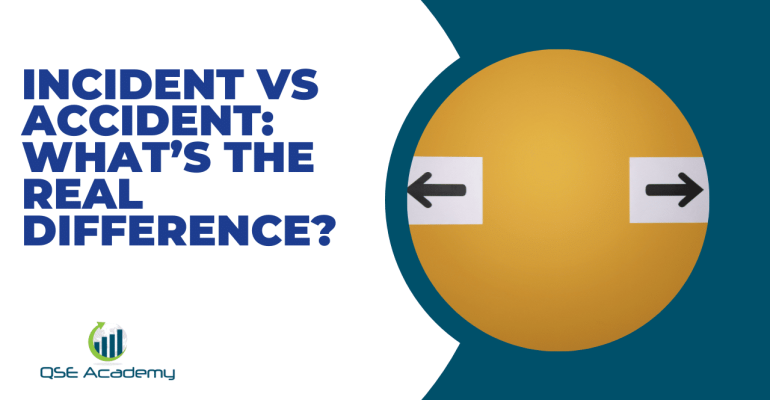Incident vs Accident: What’s the Real Difference?
Last Updated on October 13, 2025 by Hafsa J.
Incident vs Accident: What’s the Real Difference?
The difference between incident vs accident might seem small at first glance, but in safety management systems—especially those aligned with ISO standards—this distinction is crucial. Simply put:
-
An incident is any unplanned event that could have caused harm but didn’t.
-
An accident is an unplanned event that actually did cause harm, injury, or damage.
Understanding the meaning of incident vs accident is more than just semantics. It influences how organizations respond to hazards, manage risk, and improve workplace safety. In fact, ISO 45001 and other management system standards use this terminology deliberately to shift focus toward prevention.
In this article, we’ll break down the real meaning behind incident vs accident, how ISO standards define them, and why using the correct term matters for safety culture, compliance, and continuous improvement. Let’s clear up the confusion once and for all.
Defining Incident vs Accident Clearly
When discussing workplace safety or compliance with ISO standards, we need to be crystal clear about what we mean by incident vs accident. These terms are not interchangeable, and using them correctly helps organizations report events accurately and improve safety processes.
What Is an Incident?
In ISO language, particularly ISO 45001, an incident refers to any unplanned event that does not result in injury, illness, or damage—but had the potential to do so. It’s often used to describe:
-
Near misses
-
Unsafe conditions
-
Equipment malfunctions that didn’t lead to harm
This proactive view of incidents encourages reporting and helps companies fix problems before they escalate.
What Is an Accident?
An accident, on the other hand, is an unplanned event that does result in harm, such as:
-
Physical injury to a worker
-
Damage to property or equipment
-
Loss of production or time
The key difference in incident vs accident is the outcome. While both are unplanned, only accidents lead to actual harm or damage.
Using the correct terminology—incident vs accident—isn’t just a matter of language. It shapes how risks are understood, documented, and prevented moving forward.
Why the Distinction in Incident vs Accident Matters
In safety-critical industries, understanding the distinction between incident vs accident isn’t just a technical detail—it’s a key factor in risk management and legal compliance. The language you use affects the response, reporting, and prevention strategies your organization will follow.
Incident vs Accident in Practice
Here’s how this plays out in the real world:
-
When someone reports an incident, such as a slippery floor that caused no fall, it triggers preventive action.
-
When someone reports an accident, like a fall resulting in injury, it leads to investigation and corrective measures.
The incident vs accident classification changes the urgency and type of response. If every unplanned event is labeled an accident, teams may overreact or miss out on learning from near misses. If actual accidents are downplayed as mere incidents, serious safety risks may be overlooked.
Recognizing incident vs accident correctly allows organizations to:
-
Track trends accurately
-
Allocate resources effectively
-
Develop targeted training
-
Meet ISO 45001 reporting and corrective action requirements
When in doubt, categorize based on outcome: potential harm is an incident; actual harm is an accident. This simple rule helps teams stay consistent and proactive.
Incident vs Accident in ISO Standards
When it comes to ISO standards, especially ISO 45001 for occupational health and safety, the terms incident vs accident carry specific meaning and intent. These definitions help standardize how organizations worldwide handle safety events, both big and small.
ISO’s Perspective on Incident vs Accident
According to ISO 45001:
-
An incident is an occurrence arising out of or in the course of work that could have or did result in injury or ill health.
-
An accident is a type of incident that actually results in harm.
This means that all accidents are incidents, but not all incidents are accidents.
Understanding incident vs accident within this framework is essential for effective reporting and auditing. ISO standards prioritize continuous improvement, and that means identifying and learning from all safety events—not just the ones with obvious damage.
Organizations certified under ISO 45001 are required to:
-
Document both incidents and accidents
-
Investigate root causes
-
Apply corrective and preventive actions
By applying the incident vs accident distinction correctly, teams avoid confusion, reduce reporting gaps, and meet international compliance expectations. It’s a structured way to build a safer workplace from the ground up.
Reporting and Investigating: Incident vs Accident
Proper reporting is the backbone of any safety management system. But the way we label an event—incident vs accident—can completely shift how it’s handled, investigated, and documented.
Two Different Approaches, One Purpose
Here’s how the reporting and investigation processes often differ based on the incident vs accident classification:
-
Incidents are typically reported as near misses. These are close calls that didn’t cause harm but could have. Investigating them helps prevent future accidents.
-
Accidents demand more immediate attention. They usually involve injury, property damage, or significant disruption, and must follow stricter reporting and documentation procedures.
By separating incident vs accident clearly in your safety reports, you help your organization:
-
Prioritize investigations
-
Identify weak spots in controls
-
Improve safety communication
-
Stay compliant with ISO 45001 and local regulations
Also, staff need to be trained on this distinction. When employees understand incident vs accident, they’re more likely to report early warnings instead of waiting for something to go wrong. That proactive culture starts with getting the terminology right.
Training Teams to Understand Incident vs Accident
Clear understanding starts with consistent training. If your team doesn’t grasp the difference between an incident vs accident, it can lead to underreporting, delayed action, or misclassified events.
Simple Guidelines in Staff Training
When conducting safety or ISO 45001 awareness training, it’s essential to reinforce the incident vs accident distinction. Here’s how to make it stick:
-
Use real-world examples: Show what counts as a near miss versus an actual injury event.
-
Clarify intent: Stress that reporting an incident isn’t about blame—it’s about prevention.
-
Repeat and reinforce: The more the team hears and sees “incident vs accident” used correctly, the more naturally they’ll adopt the practice.
This concept must become second nature to employees. It ensures that all safety concerns—big or small—are treated with the right level of seriousness. Misunderstanding incident vs accident can mean missed opportunities to prevent the next serious event. So, well-informed teams are your first line of defense.
Policy and Documentation: Labeling Incident vs Accident Correctly
Getting terminology right in your safety documentation is more than just semantics. When you’re drafting or reviewing safety procedures, how you label incident vs accident matters both legally and operationally.
Why Accuracy Is Critical
-
Accidents typically require formal investigation, regulatory reporting, and insurance handling.
-
Incidents (especially near misses) might not need external reporting, but they demand internal tracking to prevent future harm.
Incorrectly labeling an incident vs accident can lead to:
-
Compliance gaps
-
Confused records
-
Inconsistent safety data
Standardizing the way you define and document incident vs accident across your procedures ensures that audits go smoothly, teams stay aligned, and corrective actions are appropriate. A good policy doesn’t just react—it prevents. And that starts with clarity in every report and form.
Final Thoughts on Incident vs Accident
Understanding the difference between an incident vs accident isn’t just a technicality—it’s a vital part of building a proactive and effective safety culture. An accident indicates harm has already occurred, while an incident is often a warning sign that gives you the chance to act before something worse happens.
By defining incident vs accident clearly in your policies, training programs, and reports, you create a safer, more responsive environment. Whether you’re managing safety in a factory, hospital, or office, clarity in terminology can improve communication, compliance, and overall risk management.
To sum it up, knowing the difference between an incident vs accident can help you prevent injuries, improve your documentation, and foster a workplace where safety is taken seriously. Don’t overlook it—define it, teach it, and use it consistently.
Whether it’s ISO 9001, ISO 22000, or the cosmetics-focused ISO 22716, I’ve spent my career I’m not here to call myself an expert—I prefer “enthusiast” because I truly love what I do. When I’m not writing about standards, you’ll probably find me playing Piano 🎹, connecting with people, or diving into my next big project💫. I’m an engineer specialized in the food and agricultural industry
make ISO standards less intimidating and more approachable for everyone.
turning complex jargon into clear, actionable steps that businesses can actually use.
There’s something incredibly rewarding about helping people navigate food safety and quality management systems
in a way that feels simple, practical, and even enjoyable.
I have a Master’s in QHSE management and over 12 years of experience as a Quality Manager
I’ve helped more than 15 companies implement ISO 9001, ISO 22000, ISO 22716, GMP, and other standards
My clients include food producers, cosmetics manufacturers, laboratories, and service companies
I believe quality systems should be simple, useful, and efficient.














